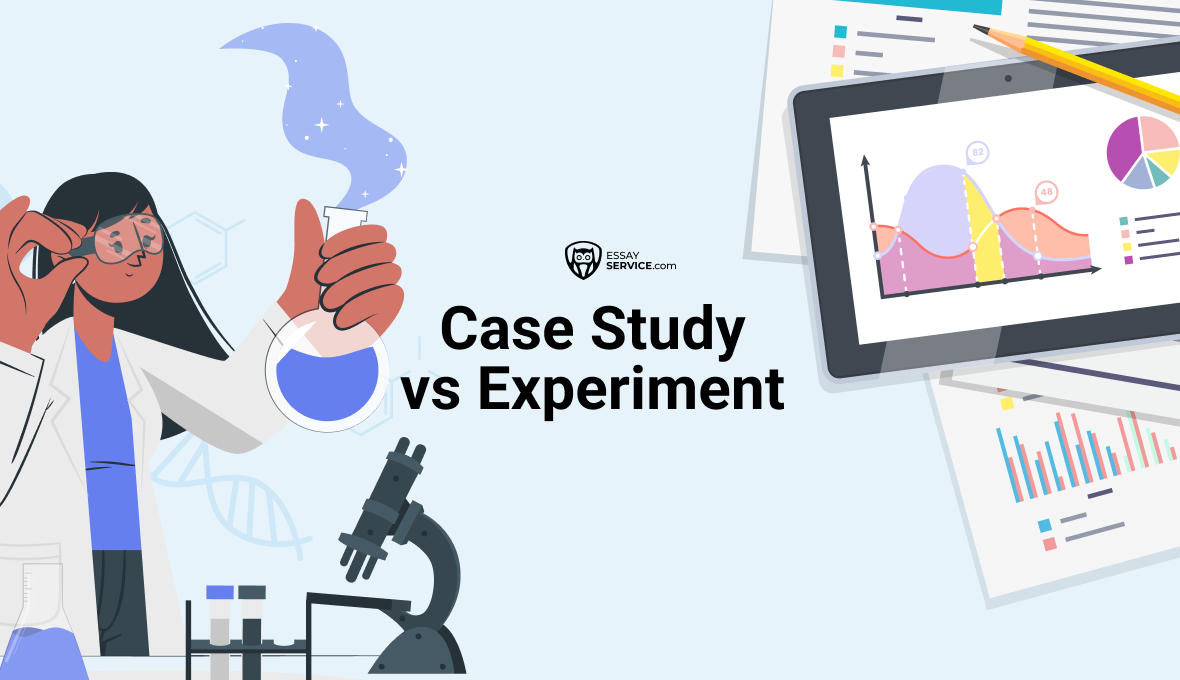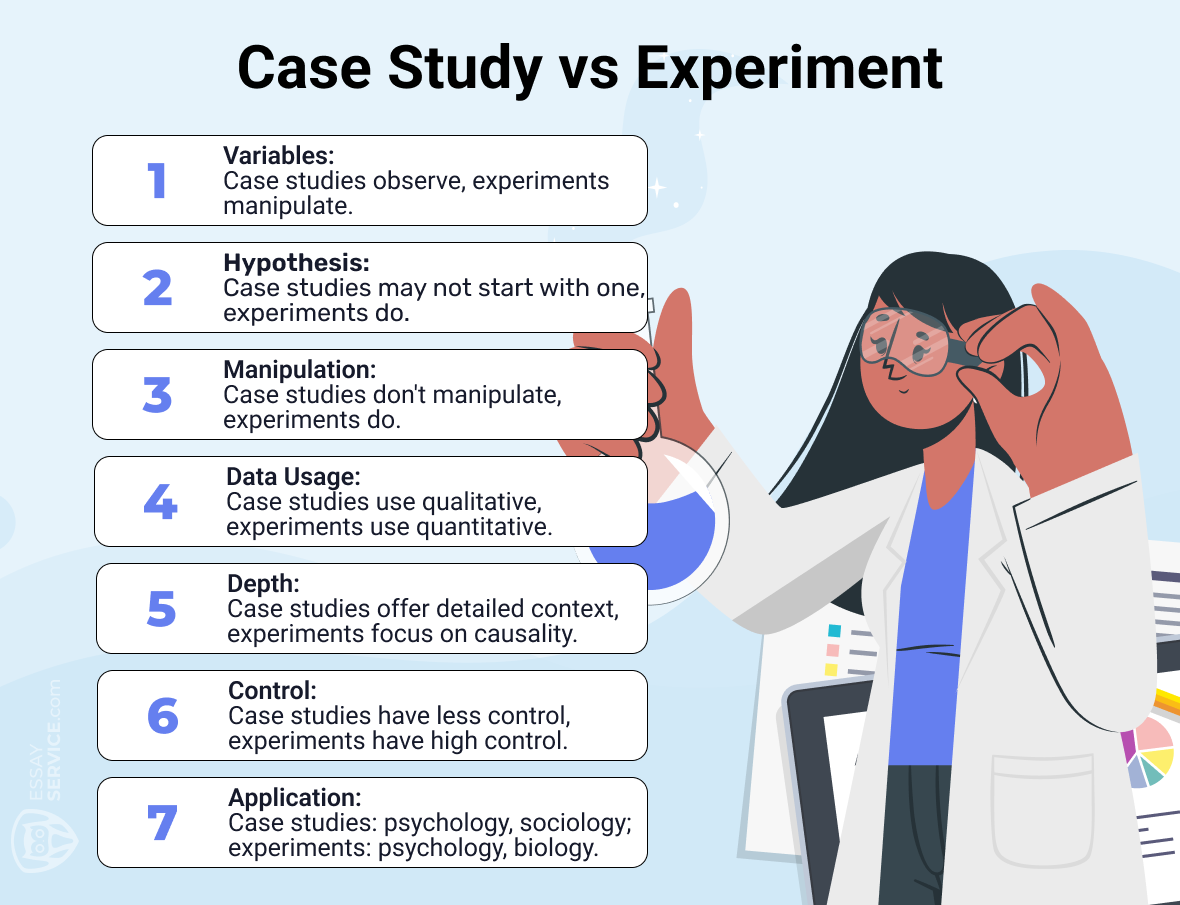
Case Study vs Experiment: Know the Difference
A case study and experiment are the two prominent approaches often used at the forefront of scholarly inquiry. While case studies study the complexities of real-life situations, aiming for depth and contextual understanding, experiments seek to uncover causal relationships through controlled manipulation and observation. Both these research methods are indispensable tools in understanding phenomena, yet they diverge significantly in their approaches, aims, and applications.
In this article, we’ll unpack the key differences between case studies and experiments, exploring their strengths, limitations, and the unique insights they offer when working with quantitative data. In the meantime, feel free to use our specialized case study writing service if you seek to streamline your efforts when handling this academic task.
What Is a Case Study?
A case study is a research method that involves an in-depth examination of a particular individual, group, event, or phenomenon within its real-life context. It aims to provide a detailed and comprehensive analysis of the subject under investigation, often using multiple data sources such as interviews, observations, documents, and archival records.
The case study method is used in psychology, sociology, anthropology, education, and business to explore complex issues, understand unique situations, and generate rich, contextualized insights. They allow scholars to explore the intricacies of real-world phenomena, uncovering patterns, relationships, and underlying factors in social sciences that may not be readily apparent through other research methods.
Overall, case studies offer a holistic and nuanced understanding of the subject of interest, facilitating deeper exploration and interpretation of complex social and human phenomena. If you’re struggling with this assignment, simply say, ‘write my case study for me,’ and our experts will help you promptly.
What Is an Experiment?
Compared to the case study method, an experiment investigates cause-and-effect relationships by systematically manipulating one or more variables and observing the effects on other variables. In an experiment, students aim to establish causal relationships between an independent variable (the factors being manipulated) and a dependent variable (the outcomes being measured).
Experiments are characterized by their controlled and systematic approach, often involving the random assignment of participants to different experimental conditions to minimize bias and ensure the validity of the findings. They are commonly used in such fields of social sciences as psychology, biology, physics, and medicine to test hypotheses, identify causal mechanisms, and provide empirical evidence for theories.
An experiment method allows scholars to establish causal relationships with high confidence, providing valuable insights into the underlying mechanisms of behavior, natural phenomena, and social processes. Other research methods include:
- Survey method: Collects research data from individuals through questionnaires or interviews to gather information about attitudes, opinions, behaviors, and characteristics of a population.
- Observation method: Systematically observes and records behavior, events, or phenomena as they naturally occur in real-life settings to study social interactions, environmental factors, or naturalistic behavior.
- Qualitative and quantitative research method: Qualitative research explores meanings, perceptions, and experiences using interviews or content analysis, while quantitative research analyzes numerical data to test hypotheses or identify patterns and relationships.
- Archival research method: Analyzes existing documents, records, or data sources such as historical documents or organizational archives to investigate trends, patterns, or historical events.
- Action research method: Involves collaboration between scholars and practitioners to identify and address practical problems or challenges within specific organizational or community contexts, aiming to generate actionable knowledge and facilitate positive change.

Difference Between Case Study and Experiment
Case Study and Experiment Definitions
Case Study
A case study method involves a deep investigation into a specific individual, group, event, or phenomenon within its real-life context, aiming to provide rich and detailed insights into complex issues. Learners gather research data from multiple sources, such as interviews, observations, documents, and archival records, to comprehensively understand the subject under study.
Case studies are particularly useful for exploring unique or rare phenomena, offering a holistic view that captures the intricacies and nuances of the situation. However, findings from case studies may be challenging to generalize to broader populations due to the specificity of the case and the lack of experimental control. To learn more about how to write a case study, please refer to our guide.
Experiment
An experiment is a research method that systematically manipulates one or more variables to observe their effects on other variables, aiming to establish cause-and-effect relationships under controlled conditions. Researchers design experiments with high control over variables, often using standardized procedures and quantitative measures for research data collection.
Experiments are well-suited for testing hypotheses and identifying causal relationships in controlled environments, allowing educatees to conclude the effects of specific interventions or manipulations. However, experiments may lack the depth and contextual richness of case studies, and findings are typically limited to the specific conditions of the experiment.
Case Study and Experiment Characteristic Features
Variables
- In case studies, variables are observed rather than manipulated. Researchers do not typically control variables; instead, they examine how naturally occurring variables interact within the case context.
- Experiments involve manipulating one or more variables to observe their effects on other variables. Students actively control and manipulate variables to test hypotheses and establish cause-and-effect relationships.
Hypothesis
- Case studies may not always begin with a specific hypothesis. Instead, researchers often seek to generate hypotheses based on the data collected during the study.
- Experiments are typically conducted to test specific hypotheses. Researchers formulate a hypothesis based on existing theory or observations, and the experiment is designed to confirm or refute this hypothesis.

Manipulating Variables
- Variables are not manipulated in case studies. Instead, researchers observe and analyze how naturally occurring variables influence the phenomenon of interest.
- In experiments, researchers actively manipulate one independent or dependent variable or more to observe their effects on other variables. This manipulation allows researchers to establish causal relationships between variables.
Data Usage
- Case studies often involve collecting qualitative data from multiple sources, such as interviews, observations, documents, and archival records. Researchers analyze this research data to provide a detailed and contextualized understanding of the case.
- Experiments typically involve the collection of quantitative data using standardized procedures and measures. Researchers use statistical analysis to interpret the research data and draw conclusions about the effects of the manipulated variables.
Areas of Implementation
- Case studies are widely used in social sciences, such as psychology, sociology, anthropology, education, and business, to explore complex issues, understand unique situations, and generate rich, contextualized insights.
- Experiments are common in fields such as psychology, biology, physics, and medicine, where researchers seek to test hypotheses, identify causal mechanisms, and provide empirical evidence for theories through controlled manipulation and observation.
Frequently asked questions
New posts to your inbox!
Your submission has been received!



